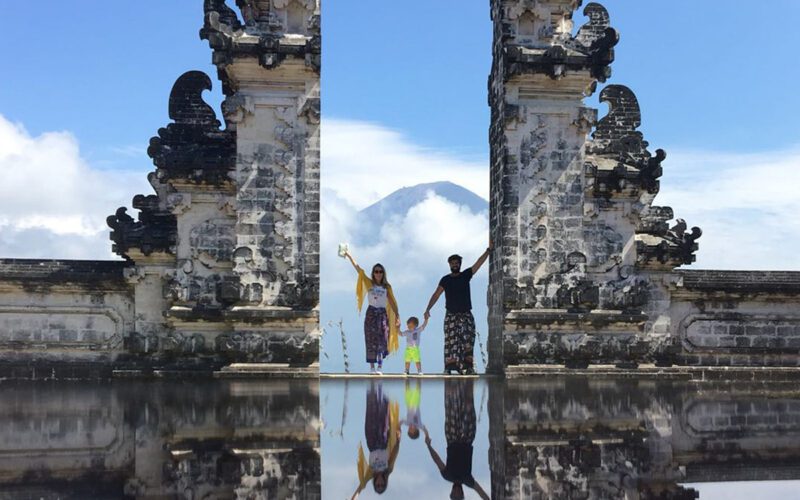How to Visit Bali’s Temples Respectfully in 2025 (New Rules, Dress Code & Cultural Etiquette)

How to Visit Bali’s Temples Respectfully in 2025
Here’s a preview – more details (and which temples to visit) below:
Bali’s temples aren’t photo backdrops – they’re living places of prayer.
As of 2025, the island’s local councils have tightened visitor rules to protect their sacred spaces.
🌿 Quick Dos & Don’ts
✅ Do wear a sarong + sash — most temples lend or rent them.
✅ Do speak softly and move calmly.
✅ Do make a small donation (IDR 30 000–50 000 helps local upkeep).
🚫 Don’t take selfies inside sanctums.
🚫 Don’t climb, sit or lean on statues or shrines.
🚫 Don’t enter if you’re menstruating — Balinese custom asks for pause.
👗 Dress Code in a Nutshell
- Cover shoulders & knees
- Tie a sash at the waist
- Remove hats & sunglasses
- Carry a sarong in your day bag — it’ll serve you from temple to beach picnic.
📸 Be Camera-Kind
- Photos are welcome in outer areas — just not during prayers.
- Skip “mock-meditation” poses; they’re seen as disrespectful.
- Better idea? Capture the ambience, the carvings, and the offerings without stepping over them.
🏡 Stay Close to the Culture
Base yourself at Melati Villa Uluwatu – just minutes from Uluwatu Temple and surrounded by wellness cafés like Alchemy Bali and The Cashew Tree.
From here, you can explore Bali’s temples with ease — and return to a tranquil villa sunset of your own.
Okay, now for the longer version for those of you with a little more time…
Everything you need to know before stepping into Bali’s sacred spaces – from updated temple rules to what to wear and how to show respect.
🌺 Introduction
Bali’s temples — or pura — are among the island’s most breathtaking and spiritually charged places. From the dramatic cliffs of Uluwatu Temple (Pura Luhur Uluwatu) to the serene lakeside shrines of Ulun Danu Beratan, these sacred sites are not just tourist attractions; they are living places of worship, ceremony, and community.
As of 2025, new cultural-preservation laws and visitor-behaviour rules have been introduced across Bali, encouraging travellers to engage with these spaces more respectfully. Whether you’re visiting from Melati Villa in Uluwatu or exploring further afield, this guide ensures your temple visits are memorable and mindful.
🏯 New Temple-Visit Rules for 2025
The Balinese government, supported by local village councils (desa adat), introduced updated regulations aimed at preserving the sanctity of temples.
Key Updates:
-
No selfies or videos inside the inner sanctum (jeroan) – photography is only allowed in designated areas.
-
No climbing, sitting, or leaning on temple walls or statues – these are considered sacred.
-
Appropriate clothing is mandatory (sarong + sash + covered shoulders).
-
Women during menstruation are respectfully asked not to enter temple areas.
-
Quiet voices and calm behaviour are expected — this includes avoiding phone use, loud conversation, or drone flights.
-
Smoking and eating are now explicitly prohibited inside temple compounds.
-
Entry fees and donation stations (dana punia) now include a small contribution to cultural-preservation programs (usually IDR 30 000 – 50 000).
These updates build upon the 2019 code of conduct (Peraturan Gubernur Bali No. 28/2019) and have been reinforced following an increase in tourism since 2023.
👘 What to Wear (Dress Code for 2025)
Balinese temple etiquette begins with attire. Most major temples provide rental sarongs and sashes at the entrance, but bringing your own shows extra respect.
The essentials:
-
A sarong (kain kamben) to wrap around your legs.
-
A sash (selendang) tied around your waist.
-
Covered shoulders – a T-shirt or light blouse is ideal (no tank tops).
-
Remove hats and sunglasses before entering prayer areas.
-
Footwear can be kept on unless signage indicates otherwise.
💡 Local tip: Carry a light cotton sarong in your day bag — you’ll use it not just for temples but also as a beach wrap or picnic blanket.
🪷 Top Temples to Visit Near Uluwatu
If you’re staying at Melati Villa Uluwatu, you’re perfectly placed to explore some of Bali’s most iconic temples.
1. Pura Luhur Uluwatu
Dramatically perched on 70-metre cliffs, this is one of Bali’s nine directional temples.
-
Don’t miss: The Kecak Fire Dance at sunset (book ahead).
-
Etiquette tip: Secure belongings — monkeys here are notoriously cheeky!
2. Pura Gunung Payung
A peaceful, lesser-known sea temple with ocean views.
-
Why visit: Fewer crowds; great for mindful meditation and photography.
3. Pura Lempuyang Luhur (Gates of Heaven)
Known for its breathtaking photo spot overlooking Mount Agung – but approach with reverence.
-
Etiquette: Photos are allowed after prayer ceremonies conclude.
📸 Photography & Social Media Etiquette
While photos of Bali’s temples flood social media, it’s important to remember that temples are active places of worship.
-
Avoid poses that mimic prayer, dancing, or meditation if you’re not participating in a real ceremony.
-
Do not touch or reposition offerings for a better photo.
-
When posting on social media, tag the location respectfully and use captions that honour, not parody, the culture.
✨ Good practice: Always credit the temple’s name and share a short note about its significance — it educates others and promotes mindful tourism.
🌄 Responsible Travel & Community Support
Every respectful visit helps preserve Bali’s cultural heritage. You can go further by:
-
Hiring local guides — they often share stories not found in guidebooks.
-
Buying sarongs or temple goods from local cooperatives.
-
Respecting signage and temple-specific rules (they vary by village).
-
Your mindfulness as a visitor ripples through communities – sustaining both spiritual and economic wellbeing.
Final Thoughts
Bali’s temples aren’t simply monuments — they’re living expressions of devotion and balance. By following these simple guidelines in 2025, you honour both the Balinese people and the timeless traditions that make the island so special.
Leave only footprints, carry only blessings.